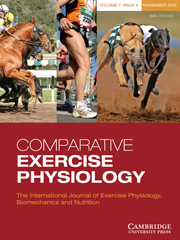Article contents
Predictive haematological and serum biomarkers for canine endurance exercise
Published online by Cambridge University Press: 05 January 2011
Abstract
Successful completion of endurance exercise is facilitated by conditioning that enhances the capacity of the cardiovascular and musculoskeletal systems to maintain a high level of aerobic activity. Insufficiency or disease in these systems may be diagnosed using routine haematology and serum chemistry testing. Pre-race blood samples obtained from 82 endurance-trained sled dogs were used to test the hypothesis that common haematological and serum chemistry values could identify subjects with occult disease, decreasing the likelihood of their finishing a multi-day exercise challenge. Multivariate logistic regression was used to identify the combinations of specific biomarkers that best predicted the eventual outcome of the exercise challenge for an individual dog. This analysis constructed six different predictive formulas. In all cases, the formulae contained the pre-race values for creatine kinase and some measurement of erythrocyte abundance. When a probability of 0.4 was used as a cut-off value, all dogs with values below the cut-off did not complete the race. These results suggest that in a population of healthy, aerobically conditioned subjects, routine clinical biomarkers can be used to identify subjects unsuited to performance for endurance exercise.
- Type
- Research Paper
- Information
- Copyright
- Copyright © Cambridge University Press 2011
References
- 4
- Cited by


